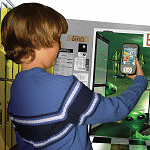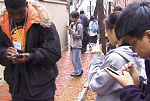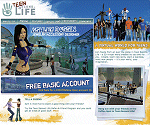When Worlds Collide: An Augmented Reality Check
##AUTHORSPLIT##<--->
Researchers are ramping up traditional MUVEs, developinggames that require students to uncover solutions in spaceswhere the real mingles with the virtual.
NOAH PATEL REMEMBERSthe first time aliens descended on hismath class at Thomas A. Edison MiddleSchool in Brighton, MA.
 The extraterrestrial buggers showed up unannounced, and Patel's students had to figure out why. Armed with handheld computers, teams of determined students set out to the school's football field to meet the intruders face-to-face. The computers, preprogrammed with specific GPS coordinates, revealed various clues via text, video, and audio as students wandered over particular spots on the field. Over the course of an hour, the students pieced together viable theories on why the Green Meanies were there.
The extraterrestrial buggers showed up unannounced, and Patel's students had to figure out why. Armed with handheld computers, teams of determined students set out to the school's football field to meet the intruders face-to-face. The computers, preprogrammed with specific GPS coordinates, revealed various clues via text, video, and audio as students wandered over particular spots on the field. Over the course of an hour, the students pieced together viable theories on why the Green Meanies were there.
"We were provided with a 'CIA' briefing talking about the suspicious landing that had taken place," Patel says. "We told the students they were going to be a part of very important research with Harvard and MIT, and that there were only a handful of kids worldwide who would have this opportunity."
No, the aliens weren't real. But neither were they figments of overactive adolescent imaginations. Instead they were the central fictional figures in an experimental learning tool created by a team of researchers drawn from a number of higher education institutions. The tool, dubbed Alien Contact!, is the leading example of augmented reality, a new strategy to enhance math and literacy curricula in K-12 districts across the country.
The technology is simple: Mobile technologies such as handheld computers and global positioning systems work in sync to create an alternate, hybrid world that mixes virtual characters with the actual physical environment. The result is a digital simulation that offers powerful game-playing opportunities. Matt Dunleavy, assistant professor of instructional technology at Virginia's Radford University, says that augmented reality is a step forward from conventional multi-user virtual environments (MUVEs), which exist exclusively in virtual space.
"It's an exciting one-two punch of virtual reality in the real world," says Dunleavy. "Teachers talk about making learning fun all the time, but this strategy gets students out of the classroom and into an environment where learning actually is fun."
As a postgraduate student at Harvard University in 2005 and 2006, Dunleavy worked with researchers from MIT and the University of Wisconsin-Madison on a special venture known as the Handheld Augmented Reality Project, or HARP. Alien Contact! was the initial result of their research; since then, a number of other games have been moved along into development.
Let the Games Begin
UNIVERSITY RESEARCHERS ARE ROLLING OUTA SLATE OF NEW AUGMENTED REALITY TOOLS.
 THE LOCAL GAMES LAB at theUniversity of Wisconsin-Madison will be introducing eight augmented realitygames in K-12 schools over the next few months. Mad City Mystery requiresstudents to solve a suspicious death. Here's a rundown of the others:
THE LOCAL GAMES LAB at theUniversity of Wisconsin-Madison will be introducing eight augmented realitygames in K-12 schools over the next few months. Mad City Mystery requiresstudents to solve a suspicious death. Here's a rundown of the others:
- SOUTH SHORE BEACH Students are called to investigate a series ofillnesses that are linked to a beach in Milwaukee. During the game,players explore the beach in order to gather virtual water samples, talkwith neighbors, make observations, and interview experts.
- DOW DAY Designed to guide students through a historical inquiry centeredon a series of anti-Vietnam War rallies that took place at UWMadisonin the late 1960s. Students role-play as journalists and mustexamine the root causes of the protests.
- GREENBUSH GAME A set of games that focuses on the urban renewalof a local historical community called the Greenbush. In one version ofthe game, the player takes on the role of a 12-year-old boy who findsout that the adults in the community are upset about the city's plan tobulldoze the neighborhood.
- MYSTERY TRIP Players hike through woods, mountains, and caves,including a 4,200-acre recreation area called the Wildlands. Developedfor a wilderness camp in Maine, the game teaches about the principlesof responsible, ethical camping, in addition to providing instruction onbotany and biology.
- HIP HOP TYCOON Students role-play in teams as specialists in business,finance, sales, and human resources, competing to build and runa successful store. The game places students in contexts where theyuse math and the language of capitalism in ways that are relevant toyouth culture.
- ARBORETUM GAME A short augmented reality tour developed for thefirst- through fifth-grade participants of a student-in-residence programat the UW-Madison Arboretum.
- SAVING LAKE WINGRA Middle schoolers are tasked with investigatingthe health of the local lake and to present a development plan forthe lake's future before the Madison City Council. Students must visitthe lake to gather research for their investigation and to gain a betterunderstanding of the environmental issues.
The goal of these games is the same-to get students more engaged in the learning process. Patrick O'Shea, the current HARP director at Harvard, says that by entailing students to walk around and rely on handhelds, augmented reality tools force them to play a more active role in their own education. While O'Shea notes that researchers have not conducted rigorous quantitative analyses on whether or not augmented reality is improving learning, anecdotal evidence does show that it is certainly boosting student excitement about learning.
Just ask Patel. After watching his students play Alien Contact! for a week, he reports that they showed more interested in mathematical tasks such as ratio proportion and indirect measurement than they had in weeks. Naturally, his best students excelled with the handhelds, but interestingly, Patel adds that he found that students who had had huge behavior problems all year were the best behaved during this time.
"It's amazing what a little change in stimulus can do," he says. "It was a nice change of pace for [all of] them from their regular classroom experience."
Alien Contact! takes students, in teams of four, across their school grounds. As they walk around the playground, parking lot, or football stadium, for instance, their global positioning systems trigger files on their PCs. This information leads to clues about the aliens-clues that help the students formulate their own answers for why the extraterrestrials have come to Earth.
O'Shea says that because each student has a handheld, educators can differentiate content so that different students receive different information over the course of the exercise. This leads to another benefit cited by educators: cooperation. In order for students to advance toward a solution, they must share information with other teams. Otherwise, O'Shea says, they won't have a complete view of the game space. O'Shea and others in the field refer to this need for collaboration as positive interdependence. Even within each group, where students assume the roles of cryptologist, chemist, computer hacker, or CIA agent, information sharing is essential, necessitating that students sharpen their interpersonal communication skills as well.
"Because this is step-by-step instruction, the only way students can move on to the next level is to collaborate, share information, and consolidate that information into some kind of code," O'Shea says, adding that within the gaming environment this kind of teamwork comes easily to students. "There's something about the gaming platform that just makes kids more comfortable working together."
While game creators admit they are still researching augmented reality technology to determine its effectiveness as an instructional strategy, they note that at this point the purpose of augmented reality games is simply to understand what impact they have on student participation and motivation.
But there's certainly more to the hoped-for outcomes than improved student engagement. Alien Contact! fulfills a variety of pedagogical requirements. Dunleavy says the game is aligned to Massachusetts state standards and fosters multiple higher-order thinking skills. In designing it, he and his colleagues targeted concepts in math and literacy typically difficult for middle school students to master. Using the spring 2005 eighth-grade Massachusetts Comprehensive Assessment System test as a reference to determine high-need areas, the Harp team focused primarily on aspects of ratio, proportion, and indirect measurement in combination with how English vocabulary has been influenced by Latin and Greek languages.
Dunleavy says that other math and English language arts (ELA) standards are embedded within Alien Contact!, such as reading graphs as well as group discussions and presentations.
In addition, the game's content and structure were made to allow for multiple entry points that teachers may build upon in future iterations. The design gives teachers the flexibility to emphasize different academic standards, different content areas (math, ELA, science, social studies/history), and different current events (energy crisis, nuclear threat, cultural differences). And the game space is layered with multiple levels of complexity.
Trying Out Some Old MUVEs
TRADITIONAL VIRTUAL-ENVIRONMENT GAMESSTILL OFFER PLENTY OF EDUCATIONAL VALUE.
 WHILE AUGMENTED REALITY presents a relatively new spin on thetraditional multi-user virtual environment (MUVE), other iterations havebeen around for years.
WHILE AUGMENTED REALITY presents a relatively new spin on thetraditional multi-user virtual environment (MUVE), other iterations havebeen around for years.
The biggest, River City,was created by a group of professors from MIT and a second group ofprofessors drawn from several universities in the US. To play River City,students collaborate in teams of three, with each student using a PClinked to a local-area network. Each student controls an avatar placedin a simulated American river town in the late 1800s. The town is facinga health crisis, and the students' goal is to find out why the residents ofRiver City are getting sick, and what can be done to help them.
To that end, students interact with residents, view archival photosfrom the Smithsonian Institute, and gather data with tools such as virtualmicroscopes and bug catchers; then they share their findings withtheir teammates. If the teacher activates the game's chat feature, thestudent teams can interact with each other electronically. Students canalso see the avatars of users from other schools, but as a precaution,the program allows them to communicate only with their classmates.
Second Life, on theother hand, facilitates more open communicationthrough its teen-specific site, Teen SecondLife. Both siteswere created by the San Francisco-basedLinden Lab. In TeenSecond Life, as in River City, users communicate via avatars. Here, however,they also can fly through a three-dimensional landscape, chat andsocialize with other teens from all over the world, and build anythingfrom skyscrapers to virtual vehicles.
Sandy Gould, Linden Lab's director of recruiting and organizationaldevelopment, sayshis burgeoningcompany's technologyis morethan a videogame and much more than an internet chat program. Instead, Gould-whose avatar often sports a Superman costume and carries around abook about the Kabbalah-says he prefers to look at the technology as aboundless world of surprise and adventure that encourages teens to worktogether and use their imagination. "It's all about creativity," he says.
TO READ MORE about traditional multiuservirtual environments, see "All the RightMUVEs" in our September 2006 issue.
Dunleavy says that by using augmented reality games to engage students in math and literacy, the hope is to reveal to them the fascinating elements inherent to both subjects. "The rationale is to build in mathematical and linguistic patterns that, when recognized, reveal the ubiquity and mystery of math and language," Dunleavy says, "and to build in multiple layers of complexity that will engage and challenge students regardless of ability, and will provide teachers opportunities for differentiation.
ROAR and More
Dunleavy's project for his new employer, Radford University, is appropriately called the Radford Outdoor Augmented Reality (ROAR) Project. As with HARP, the goal of ROAR is to design and study engaging and effective augmented reality outdoor learning environments using wireless handheld computers equipped with GPS receivers.
ROAR's augmented reality tools work exactly like those created by HARP. As students move around a physical location, such as their school playground or sports field, a map on their handhelds displays digital objects and people who exist in a virtual world superimposed on real space. When students come within approximately 10 feet of one of these digital elements, the augmented reality and GPS software programs trigger video, audio, and text files that offer narrative and navigational clues and prompt students to work together, as well as provide academic challenges that must be answered before students can receive more information. "It's like a modern-day treasure hunt," Dunleavy says, "only with far greater rewards."
Over the next six months, Radford researchers will develop and field-test several augmented reality games in a number of participating southwest Virginia schools. In the meantime, technologists at MIT are continuing to improve the underlying software, which is written in a form of HTML.
Eric Klopfer, director of MIT's Scheller Teacher Education Program, is one of those technologists. Recently, Klopfer noted that Alien Contact! and other augmented reality games are now all built on this software, as are some of the games MIT has created on its own. These include Charles River City, a public health MUVE based loosely on River City (see "Trying Out Some Old Muves"), and Mystery at MIT, an environmental science game.
The school's technologists also collaborated on a game with Ohio's famed Columbus Zoo, titled Zoo Scene Investigators. Students use teamwork, cognitive thinking, and problem-solving skills to get to the bottom of a recent zoo break-in. The game is being played by middle school visitors to the zoo, and will soon be used as a part of the Missouri Botanical Garden Local Investigations of Natural Science (LION) initiative.
"Some of the benefits come from the sense of authenticity that one can get from role-playing games in the real world," Klopfer says. "Students don't often have the opportunity to do these kinds of activities and work with interesting, complex problems, and because they are physically involved in them, they care about the solutions."
"Teachers talk about making learning fun all the time, but this strategygets students out of the classroom and into an environment wherelearning actually is fun."
—Matt Dunleavy, Radford University
What's Next
While HARP and ROAR are the only two widespread augmented reality projects today, other iterations are in the works. Many of the new games are coming from the Local Games Lab, which is affiliated with the University of Wisconsin- Madison. There, Kurt Squire, assistant professor of educational communications and technology, is the lead on a federal Department of Education grant looking at the potential of augmented reality to increase the mathematics and literacy skills of disadvantaged middle school students.
Squire's group is working on eight games overall (see "Let the Games Begin"). Perhaps the most successful of the bunch is Mad City Mystery, which requires students to interview virtual characters about the possible causes of the drowning death of a friend. Squire says environmental toxins may be to blame, including mercury found in fish, TCE (trichloroethene) found in the factory where the victim worked, and PCBs (polychlorinated biphenyls) found in groundwater and fish.
"A question we often get is 'How are these games?'" Squire says. "Most computer games aren't really 'games,' but instead they focus on providing a 'designed experience' to heighten engagement, encourage collaboration, and facilitate learning. Ours do that too."
As one example of these designed experiences, each of the eight Local Games Lab creations involves differentiated roles that require players to adopt reading strategies to understand texts. Mad City Mystery, for example, includes a triggered event designed to induce reflection. Midway, a character appears and challenges student interpretations of the facts, offering a counter theory that the death they are investigating wasn't an accident, but a suicide connected to insurance fraud. Without fail, says Squire, the exercise gets students thinking.
Still, games like Mad City Mystery and Alien Contact!, are still considered merely novelties. Squire says that perhaps the biggest challenge to augmented reality is the logistics of getting these types of software programs onto handheld devices, then distributing those devices on a large scale. He adds that, currently, the tools take far too much setup and programming effort on the part of teachers-a burden that should be alleviated as augmented reality technology improves over time.
"I'm not a fan of 'one-size-fits-all' kinds of educational programs, as they de-professionalize teachers, but right now, doing an augmented reality game for one's community involves hours of setup, design, and so on," Squire says. "Our immediate hope is to provide better templates and tools for teachers so that they can use and adapt this technology in creative ways."
Matt Villano is a freelance writer based in Healdsburg, CA.